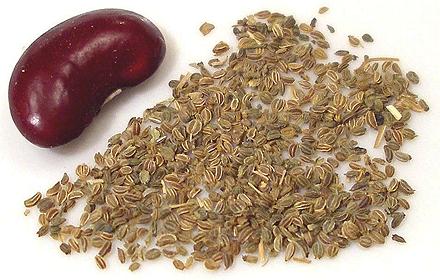 [Apium graveolens var graveolens]
[Apium graveolens var graveolens]
Celery seed (actually very tiny fruits) are produced from "Wild Celery" rather than the Pascal variety. Much of what is sold as "celery seed" is mixed with or even entirely Lovage Seed. Apparently lovage is a better seed producer, but is very closely related to and very similar to wild celery. The photo specimens were 0.055 inch long by 0.022 inch wide ( 1.4 x 0.6 mm).
More on Parsley & Aralias.
Celery seed is often ground 1 part to 3 parts salt to make Celery Salt which is used as a table condiment, in the bar drink "Bloody Mary", on Chicago style hot dogs, and in Old Bay seafood seasoning. It also has strong medicinal properties. Celery seed contains significant amounts of nitrites, so it acts as a mild preservative.
Buying: While not the easiest spice to find, some well stocked spice sections do have it. In an airtight jar stored away from light and heat, it should be good for about a year.
Medicinal: Celery seed was known for treatment of pain and inflammation earlier than 30 BCE, but this use is not recognized by the FDA, and the Pharmaceutical companies won't sponsor testing because they can't patent it. Studies in Australia and South Africa have shown celery seed extract effective in treating and preventing inflammation, and especially gout. It is said to both promote removing uric acid from the blood, and to have a whole array or anti-inflammatory components.
"Hearsay evidence" strongly supports those studies. To this I add my own testimony, and mention that if you don't have the extract, eating a couple celery heads a day will also work in an emergency - get ones with thin stems and lots of leaves and side branches, and eat the whole things. Even better, get a pile of Chinese / Cutting Celery - that type, and it's wild relatives, are where the Celery Seed comes from.
Health & Nutrition: Some people have a celery allergy, similarly dangerous to peanut allergy.
py_celseedz 160528 - www.clovegarden.com